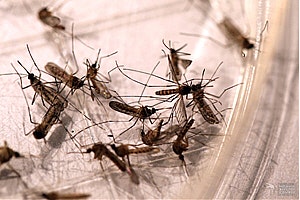2012 Record-Setting West Nile Virus Season Ends
Why Did it Happen in the First Place?

It’s over. The cool temperatures that usher in winter weather are finally here, spelling the end of West Nile Virus Season 2012. For the Contra Costa Mosquito & Vector Control District, it is an end that could not come soon enough because this West Nile Virus Season was one for the record books. Nationwide, 5128 people are known to have been infected with the virus this year, while the Centers for Disease Control and Prevention now estimate as many as 182,100 people may have actually been infected, but suffered such low-level symptoms they did not seek medical attention or testing.
According to the CDC, the number of people infected with West Nile Virus in 2012 is the largest national outbreak since 2003 when 9862 people were diagnosed with the mosquito-borne illness. In the years since 2003, the number of human cases has fluctuated between 2,000 and 4,200 until 2006. That’s when the infection rate steadily declined until this year. Why did the number of cases skyrocket from 712 last year to 5128 this year? There are most likely several contributing factors including weather, lack of resources, and neglect that created the perfect storm.
When 2012 began with a mild winter that transitioned into a warm spring followed by a long, hot summer, the elements rapidly formed to create a serious West Nile Virus season. Warm weather marks the return of birds to many areas and leads to an earlier emergence of previously infected mosquitoes from their winter hibernation. When the birds sought water, experts theorize they came within close proximity to mosquitoes that need to lay their eggs in water, increasing the odds the virus would spread between the birds and mosquitoes.
“Warmer temperatures increase the risk of West Nile Virus because they allow mosquitoes to develop from egg to adult faster, efficiently creating a larger mosquito population,” said District Scientific Program Manager Steve Schutz, Ph.D. “The virus itself also needs warmer temperatures to reproduce in the mosquitoes. If infected birds are close to an expanding mosquito population, the ingredients are ripe for disease transmission.”
Much of this year’s national West Nile Virus epidemic centered in Texas, where 1697 people were diagnosed with the virus. Experts say the weather was definitely a contributing factor as the state experienced several weeks of heat wave conditions with intermittent thunderstorms that provided water where mosquitoes could complete their development into adulthood. But in Texas, particularly in the hard-hit city and county of Dallas, the four employees who were trained in mosquito source reduction and surveillance were unable to keep up with the virus outbreak that arrived. Mosquito management for the city of more than 1.2 million people falls under the jurisdiction of the Department of Code and Compliance. That is typical of many areas in Texas that do not have dedicated mosquito abatement districts. According to a Dallas television station investigation, records show due to a few mild mosquito seasons, local officials did not purchase growth regulating larvicide that prevents mosquitoes from maturing. But this year, as a record number of citizens became infected with the virus, area officials scrambled to deal with the public health threat, conducting aerial mosquito adulticide spraying for the first time in nearly 50 years. The mayor of Dallas told citizens at a city council meeting that public health officials will make plans to prevent a repeat next year.
“We will be working as soon as this issue is over for this year to prepare for next year, understand why it’s happening, where it’s happening,” said Dallas Mayor Mike Rawlings Closer to home, Contra Costa County‘s West Nile Virus season started unusually early when the first bird tested positive for the virus in April – nearly three months earlier than the previous year. That prompted the District to increase efforts in the Integrated Vector Management program which is a proactive approach to prevent mosquito production by using physical, biological, chemical and communication tools. In known sources of water, the District uses mosquito-eating fish, physical control, and public health pesticides to prevent mosquitoes from developing into adulthood. At the same time, the District’s Public Affairs staff educates the public about dumping out water that collects on private property. The approach proved successful in some areas, but the virus continued to challenge other areas. One location that turned out to be particularly tricky was near Heron Park in Brentwood. The District conducted door-to-door surveillance in the surrounding neighborhood and worked to prevent mosquitoes at every available source. But even after these efforts, the District still trapped infected mosquitoes.
In accordance with the District’s public health protocol, the District fogged the area seven times over three months to kill adult mosquitoes and reduce the risk that they would infect humans. At the same time, the District isolated the suspected source of the mosquitoes; unmaintained storm water detention basins. The basins were full of dense vegetation that prevented proper mosquito treatment, but allowed for plentiful mosquito production. By working with several entities including city of Brentwood officials, the vegetation was reduced, allowing for improved mosquito control.
The 2012 West Nile Virus season was daunting to say the least, but will 2013’s season be equally as challenging?
“West Nile Virus has a short history in California, but in those 10 years what we do know is some years are worse than others,” said Schutz. “The 2012 season teaches us that just because we had a few mild seasons recently, we still must be prepared to reduce the risk of future outbreaks because it’s not if, but when the next emerging disease will arrive. “
With that goal in mind, the District is currently conducting training; reviewing protocol, and preparing for next year by making sure we avoid a reoccurrence in known sources and working daily to try to prevent new sources from producing a record-breaking outbreak in 2013.
